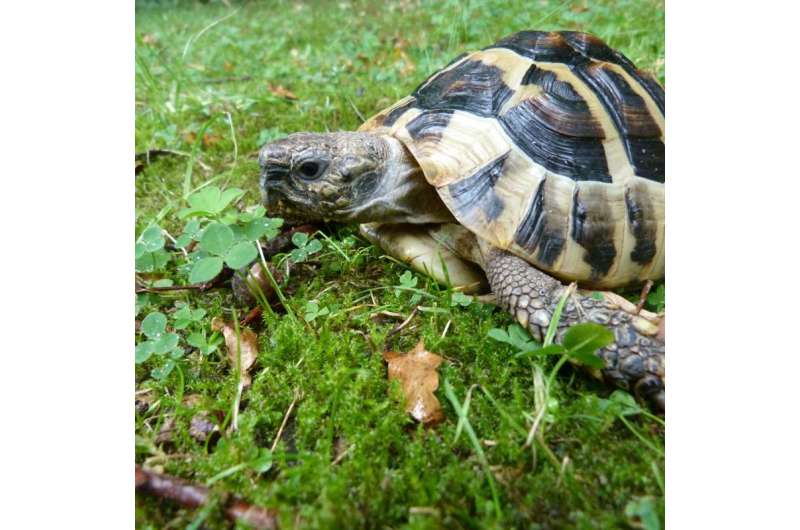Testudo hermanni (Hermann's Tortoise) – the trading of tortoises as pets has contributed to the spread of infectious diseases. Credit: University of Liege
Researchers may have found the basis for a vaccine against a disease that threatens endangered tortoises.
Over thirty years on from the initial discovery of the tortoise herpesvirus, a team of researchers from Lancaster, Glasgow and Liège universities, has, for the first time, sequenced the complete genome of two strains of the virus TeHV-3, which is the most pathogenic of four species of herpesvirus that cause diseases in tortoises.
The researchers have evidence strongly suggesting that the TeHV-3 virus exists in a non-lethal form, called m1, which may be the starting point of a vaccine.
The researchers found that, when they delivered a mixture of three different forms of TeHV-3 to tortoises as a nasal spray, m1 was not able to attack the internal organs, meaning that on its own it may prompt the immune system to produce antibodies against TeHV-3 without causing disease. This could be the beginning of a live vaccine capable of protecting tortoises from lethal forms of the virus.
Virtually all of the 40 known species of tortoise are suffering declines in their natural populations, due to infectious diseases, as well as to the pet trade and habitat destruction caused by human encroachment and climate change. Herpesviruses are important as a group because they infect many species of animals from invertebrates like oysters to vertebrates like humans.
Dr Derek Gatherer, of Lancaster University's Biomedical and Life Sciences Department, explained: "Tortoises are beautiful creatures that have been on the planet for a very long time – a 240 million year old fossil was found this year in Germany. It would be a great tragedy if they were to become extinct in our lifetimes.
"We have to do everything we can to protect and conserve them, and shielding them from infectious disease outbreaks is a major conservation priority. With this work we have shown, firstly, that we can begin to develop a vaccine against the tortoise virus, and, secondly, through analysis of the TeHV-3 genome, that the herpesviruses that attack land-dwelling tortoises and marine turtles are similar to each other. "
The team also found that, like many viruses, TeHV-3 has some genes that have been captured from host tortoises in the distant past. These genes are often crucial in helping the virus evade or fight against the tortoise immune system. These discoveries will prompt greater understanding of the way the host and virus interact and lead to future drug treatments.
Dr Andrew Davison, of the University of Glasgow, said: "This work illustrates how viral genomics can help our understanding of how viruses cause disease and how we might be able to intervene. This process is especially important for animals that are facing continuing decline in the modern world."
Professor Alain Vanderplasschen, of the University of Liège, said: "Tortoises, like many other animal species, suffer from being treated as pets. The trading of tortoises has led to a level of international mobility that is not natural to them, resulting in the spread of infectious diseases and also to the emergence of new diseases. As a result, fresh treatments need to be developed to prevent the extinction of endangered species by viruses and other pathogens. The development of vaccines is certainly one of the most effective measures we can take. The potential of m1 as a vaccine is currently under testing at the University of Liège. The results will be known in 2016."
More information: Frédéric Gandar et al. The Genome of a Tortoise Herpesvirus (Testudinid Herpesvirus 3) Has a Novel Structure and Contains a Large Region That Is Not Required for Replication or Virulence , Journal of Virology (2015). DOI: 10.1128/JVI.01794-15
Journal information: Journal of Virology
Provided by Lancaster University





















